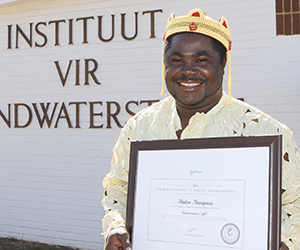
Prof Abdon Atangana, from the UFS Institute
for Groundwater Studies.
Photo: Johan Roux
Thirty-year-old Prof Abdon Atangana has received the prestigious Sentinels of Science Award 2016. This award honours the highest achievers in peer review across the world’s journals. The elite contributors to scholarly peer review and editorial pursuits internationally are also honoured with this award. Recipients have demonstrated an outstanding, expert commitment to protecting the integrity and accuracy of published research in their field.
Prof Atangana, who ranks number one in the mathematics discipline with a merit of 324, is a professor at the Institute for Groundwater Studies at the University of the Free State (UFS).
He is editor of 17 international journals, editor-in-chief of two international journals and also reviewer of more than 200 international accredited journals. He has been lead and guest editor of some special issues. He is also editor of 19 journals of applied mathematics and mathematics and has presented and participated in more than 20 international conferences.
Prof Atangana’s research interests are methods and applications of partial and ordinary differential equations, fractional differential equations, perturbations methods, asymptotic methods, iterative methods, and groundwater modelling.
“Editors in more than 100 journals
trust my opinion to assess
whether a submitted paper
can be published or not.”
Peer review requires a respected expert in a given field
According to the professor, reviewers play a central role in scholarly publishing. “In the academic field, peer review is the process of subjecting an author’s scholarly work, research, or ideas to the scrutiny of others who are experts in the same field, before a paper describing this work is published in a journal or as a book. The peer review process helps the publisher to decide whether the work should be accepted, considered acceptable with revisions, or rejected.
“Peer review requires a respected expert in a given field, who is qualified and able to perform the review in a given timeframe. Due to the impact of my research papers in the field of mathematics and applied mathematics, and also my international recognition in the field of applied mathematics, many editors in more than 100 journals of applied mathematics trust my opinion to assess whether a submitted paper in a given journal of mathematics and applied mathematics can be published or not. Only this year I was able to review more than 100 papers from different journals of applied mathematics, applied physics, mathematics, engineering and hydrology,” he said.
A successful peer reviewer displays passion for the development of science
Key to his success as peer reviewer is his passion for the development of science, his ability to write fair reports about a given manuscript, as well as his knowledge on what has been done and what are the challenges in a given field to be able to give a report that will help the advancement of science.
Currently he is developing new mathematics tools that will be used to accurately model statistical problems as well as physical problems with many layers.
“To be the number one peer reviewer in the world in mathematics is a product of love, patience and determination to enhance science,” Prof Atangana said.
His advice to young researchers is to put their trust in God and to work hard. “Not necessarily for money but for love because the future of Africa is in the hands of young Africans,” he said.